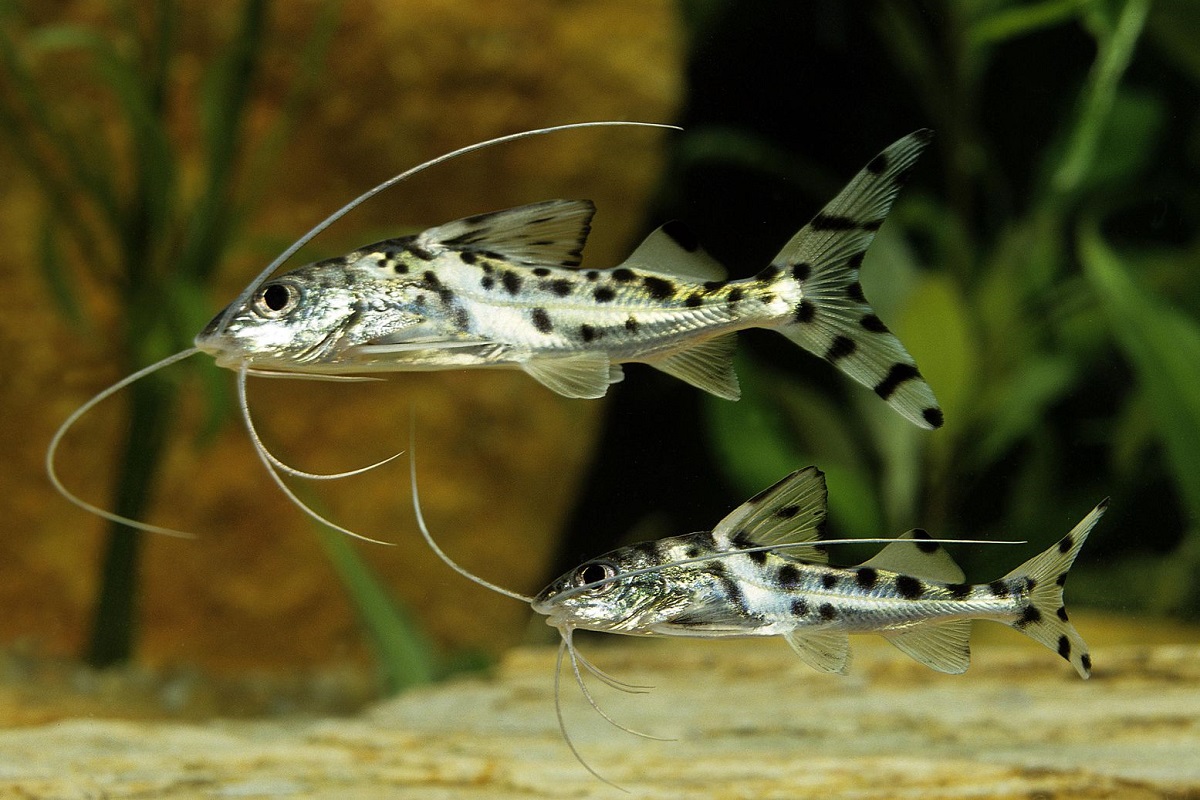Pictus catfish is one of the favorite and most preferred freshwater fishes.
There are a lot of reasons why hobby fish keepers find them appealing. From the bright contrasting shades of black spots on a silvery-white body to their highly delightful and energetic personality,
Pictus catfish make for an ideal choice for your home aquarium or a community tank. They are very active, move around pretty fast, and are extremely cute.
Pictus catfish are primarily nocturnal, and peeps find their energy and long barbels pretty appealing! There is something about this pretty cute fish that adds in the playful and natural touch to the aquarium tank.
Pictus catfish are not aggressive and can live with other fish varieties once they get acclimatized with their buddies.
Contents
Species Summary
Pictus catfish, also known as Pimelodus Pictus, is a massively renowned freshwater fish prevalent among the aquarists for quite some while.
Pictus catfish is from the Pimelodidae family & originates from the Amazon river basins & Orinoco in South America. However, it is known to drift a little further from its hotspot on events easily & is found in Peru.
They are more active swimmers than other mellow catfish relatives. Many new owners do not expect this & are extremely surprised when they view these fish’s speed.
Lifespan

While Pictus catfish have the potential to live for long, it is on assuming that you provide them good care. Poor diet, insufficient water conditions & breeding attempts can shorten their lifespan to a great extent.
You must take good care of Pictus catfish if you want to behold their beauty for a long time.
Note that if you keep a pet in captivity, it is completely on your obligation that you go the required mile to ensure their well-being. So, if you plan to bring a Pictus Catfish to your aquarium, arrange for all the necessities and ensure they thrive well.
Appearance
At first look, the initial thing that comes to your mind is their appealing barbels. Few people also address them as whiskers.
These barbels endow them with a highly distinctive appearance & make them unique amongst the rest in the aquarium tank.
It is certainly not uncommon for them to evolve to match their bodies’ length. Also, it is fun to view them sway. Their barbels’ purpose is to assist them in navigating & feeling their way around sordid water.
Though this is not something they will require to utilize much in your marine aquarium, it still caters to them with added spatial awareness.
Pictus catfish bodies are shiny, light, silverish in color, which extends uniformly all over their existing body. They have a belly, which is a little lighter in the shade. Such fishes also do not have any scales.
Dark dots are scattered over their bodies, which are evenly spaced. However, these dots are less present over their tummy. On their caudal fins and dorsal, you will find black spots.
Pictus Catfish Size
The size of the average Pictus catfish in length is about 5 inches. When they are grown up, it is very uncommon for such fishes to surpass this size, but it may be possible in some cases.
Quality of diet and care play a significant role in their growth. Moreover, when you buy a Pictus catfish, the fish’s condition can significantly impact how large they may become eventually.
Pictus Catfish Care
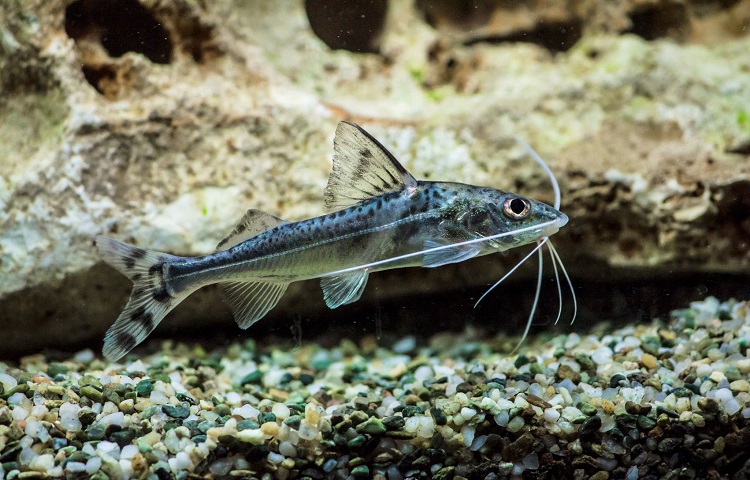
To take care of Pictus catfish is not tough if you know the most basic guidelines.
Such fishes are extremely easygoing & low maintenance, which is good for those aquarists who dislike witnessing hassles. However, please note that the pectoral fins of Pictus catfish are very sharp, so you need to be extremely careful while handling them.
When transporting them, do not use the regular fishnet, their fins will get stuck to the net, and it will cause damages.
How Big of Tank Does a Pictus Catfish Need?
Pictus cats generally prefer a massively planted tank with logs and rock caves along the bottom & are even much better with sandy, soft substrate instead of harsh gravel that holds the chance of injuring their extremely delicate barbels.
Though they do spend a few of their time hiding, they even require extremely large open spaces with a swift current to exercise in. Those who arrange their filter outflows can easily direct steady current along lower portions of extremely open regions for these species to enjoy to the core.
The perfect setup for single Pictus catfish is between 55 and 75-gallon long-styled aquarium with natural rocks and live plants or even branch decorations along sides and back & open regions in the center. The preferred size is 55 inches as these fishes appreciate the additional space they get.
Thus, plan on adding 40 to 50 more gallons for each of the extra fish you keep. We recommend keeping the tank size large enough to let them swim around freely. Even though Pictus catfish are small in size, they require adequate room to roam about easily.
These fishes are very active, swift, and busy. In case you keep them in tiny tanks, these fishes may get stressed and even lack the necessary enrichment.
After all, they are active swimmers, and the more freely they can move around, the healthier and livelier they will be. So, if you plan to add Pictus catfish to your water tank, ensure to keep enough room for them to swim around freely.
Water Parameters for Keeping Pictus Catfish Healthy
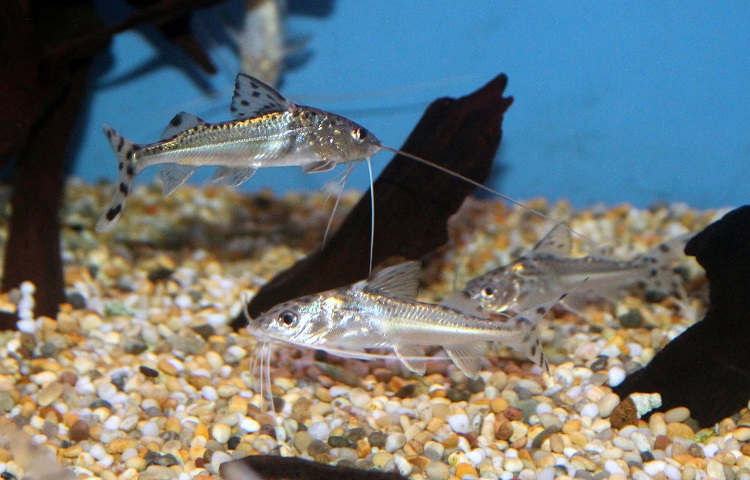
Pictus catfish require straightforward care where you will need to spend crucial time paying attention to the tank’s existing water parameters & levels. Straying just outside the advised ranges can cause problems for such fishes.
- Water Temperature
70 to 80 degrees Fahrenheit is a commonly utilized range, but the recommended range is 75 to 80 degrees Fahrenheit.
- pH Levels
You must target maintaining the pH level between 6.5 to 7.5. We have heard from peeps who have managed well with slightly lower pH, such as soft water, to keep the Pictus catfish healthy.
- Water Hardness
Aim for maintaining the water hardness between 100—150 ppm. Ensure to run constant tests to ensure that the water levels remain within the advised ranges. Being consistent and frequent with your assessment can help you figure out the change before getting dangerous.
Where Should You Place Them in The Tank?
In the habitat such Pictus catfish belong to, you should try and mimic it to keep them stress-free, comfortable and healthy. The initial thing we suggest is including some plants in the tank.
In their habitat, Pictus catfish regularly swim & navigate through a reasonable number of vegetations. Including in some plants such as Hornwort will make them stress-free and extremely home as they would feel just like home.
Other inclusions can be driftwood and rocks. Such fishes require a hiding space where they can easily go to and feel safe & these can make them feel so.
Are Pictus Catfish Aggressive?
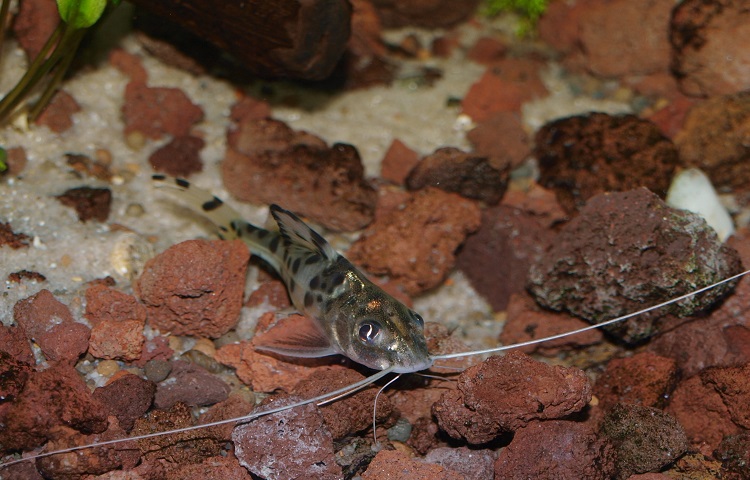
No Pictus catfish are not at all aggressive, most times & they are even not territorial. They may fight each other, particularly males. However, they most likely are friendly.
Those setting up their tank must conduct a little research before keeping Pictus catfish as it matters much more than you may think. Those fishes that are peaceful & non-aggressive go well with one another.
You must consider not putting those highly aggressive fish in the same tank as Pictus catfish. This can hamper the entire ecosystem & upset the Pictus catfish and other fishes residing in the tank.
Will Pictus Catfish Fight Each Other?
Those looking to include another Pictus catfish in their aquarium should consider the fish type you are getting. Mostly, catfishes together do just fine as they are shoaling fish, which means they prefer to stay in numbers.
But in some events, catfish can chase one another & even fight each other. That is particularly the situation if they are kept in extremely low numbers. This is when such aggression can take place, particularly between male species.
In extremely difficult situations, they even can injure one another. That is why you will avoid it by keeping several fishes together. Doing so would ensure such aggressive behavior did not take place.
Thus, why it may happen should now be thoroughly clear, and what we should do to prevent it is also crucial to note. Ensure to keep them in number and avoid keeping them in small numbers as they may become aggressive.
How to Prevent Pictus Catfish from Fighting?

The major reason why the Pictus catfish fight against each other is because we permit them to do so. You must consider various things to prevent such behavior, and these are super simple fixes that can help them stay friendly.
- They feel safe in groups of 5, so keep them in huge numbers.
When you keep them in low numbers, they may begin to feel highly insecure & begin to fight. Such aggressions may even turn into massive fights with other fishes. In case the fight gets very serious, catfish has the probability of getting hurt.
- Ensure to cater them with sufficient hiding place & adequate swimming space
The next crucial thing you have to remember is catfish love to hide, particularly if they get the feeling of being endangered. That is why you must give them adequate space in your tank to easily move about and swim, even when you keep them in huge numbers. Also, ensure they have sufficient hiding spaces such as plants, rocks, caves, and various other decorative elements.
Thus, remember, if we fail to provide them with what they need, they may become stressed and enter into fights. Thus, it is your responsibility to prevent this from happening. Follow the above two points so that your Pictus catfishes are happy.
What Fish Can Live with A Pictus Catfish?
While Pictus catfish are known for being anti territorial and non-aggressive, there are several instances you should know when keeping them with various other fish types:
- They can eat smaller fishes when they are hungry. Thus, note to feed them well to avoid such instances. Also, you can ensure not to keep them with other small-sized fishes that can quickly get inside their mouth.
- Pictus catfish are highly known for being extremely active, fast & even energetic swimmers. Thus, for this reason, ensure to avoid including slow swimming fishes like cichlids into your aquarium tanks as Pictus catfish can irritate these fishes and even can harm these slow swimming species with their highly sharp barbels.
- They are bottom-dweller community species, and if your aquarium is packed with popular community fishes such as neons and guppies, it is best to avoid Pictus catfish.
- The general thumb rule ensures that Pictus fish is the only smallest fish in your aquarium. While it is a friendly and peaceful fish, they are even a predatory species.
Thus, if you remember these above pointers, you are sure to have no issues when introducing other fishes to your tank. As which species can make really good mates with catfish are energetic, strong fish species like:
- Opaline Gourami
- Giant Danios
- Other Pictus catfish such as Doradidae, ie. The Striped Raphael catfish, Loricariid, etc
Keeping Pictus Catfish Together
It is not uncommon for peeps to keep a single Pictus catfish as they can survive with no problems. But people who prefer to keep them with other Pictus catfish or fish of different varieties should keep them in shoal as they by nature are shoaling species.
The benefit of keeping them in a shoal is that they are way too active & will become more outgoing. Pictus catfish do exceptionally well in shoals of 5 in general, and you can even keep up to six at once. However, ensure your tank is big enough. Recommended tanks of nearly 150 gallons are best when keeping them in groups.
Also, note that Pictus catfish eat other smaller fish if they are hungry. So, you should make sure not to place smaller fishes that can easily fit into their mouth.
Also, avoid adding slow swimming fish to a Pictus catfish tank as this active swimmer can irritate and cause damage to the slow-moving fish in the tank.
What Do You Feed a Pictus Catfish?

Few Pictus catfishes are scavengers and eat a lot and nearly everything they find. Note that by nature, they are omnivorous; thus, you can feed them both plant and meat matter.
In hot waters from where they initially originate, that is, in South America, they are found guzzling insects such as dragonfly larvae, small fishes, snails, and even algae.
This particular habit of Pictus catfish makes keeping them and feeding them way more straightforward and easier than managing other varieties of fish. They can consume nearly anything you put in your tank.
However, the core diet of catfish should remain high-quality pellets. As they love spending highly long periods of their time in extremely hidden spaces near the tank’s bottom, ensure to use sinking pellets. To cater them with few varieties you can use food like:
- Vegetables
- Frozen food such as Blackworms & bloodworms
- Fresh food such as Beef heart & brine shrimp
Also, they spend a few periods foraging in the substrate of your tank. Thus, you can leave any of the algae growing as your Pictus catfish can guzzle them when hungry. Please note that they generally avoid most top-dwelling living food like they do not like venturing away from the bottom of the tank.
Finally, it must be repeated that they have a huge appetite. You must make sure you keep them full to prevent aggressive behavior with smaller fishes existing in the aquarium. Additionally, as they produce massive waste, you must make sure to clean their water bi-weekly.
How Often Should I Feed Pictus Catfish?
Pictus catfish must not be treated differently from the aquarium’s remaining fishes. They require similar kinds of food like other fishes at the same time.
Of course, the Pictus catfish will look around for leftover food throughout the day and night, but they still have similar feeding needs as the other fishes. As a feeder, you require giving them every chance to feed like all other fish kinds.
Few Pictus catfish are even capable of guzzling smaller fishes such as Zebra Danios and Neon Tetra, thus be careful. Note these fishes are active and fast swimmers & can simply stress out on other smaller fishes in events when they are not fed correctly.
Why Is My Pictus Catfish Swimming Up and Down?
Pictus Catfish prefer to swim up & down the side of glass over & over again at times when they are highly stressed.
They also appear to talk or communicate with their mouth. When they are happy and content, they do not conduct such activities and are usually calm sitting on the tank’s bottom or race around swimming.
Breeding the Pictus Catfish
It is not an easy task to breed the Pictus catfish. They are challenged to sex and, most times, refuse to reproduce except when they are in a group. Since they are egg layers and mostly lay their eggs on various surfaces in the tank, it is best to keep them in a giant aquarium.
Once the group of Pictus catfish is placed inside the tank, the females begin to pursue the males around the tank. While in pursuit, the males will release their sperm, and the females will pick it up with their mouths. They will later go to a safe area and lay their eggs. At least 100 to 200 eggs are laid and will hatch after some days.
Once the eggs are hatched, the fry will be left by the females to cope alone.
Raising The Fry
The fry of the Pictus Catfish is tiny and challenging to raise. You must feed them with live food such as microwaves and baby shrimp. They will need to be fed for some days. After that, they can swim and fend for themselves.
Remember that during this period, it is crucial to maintain high water quality. This is because the fry is vulnerable to changes in the water. With proper care, they will grow gradually but will attain maturity in three months. Lastly, always quarantine new breeding fish before putting them in your breeding tank, especially from different sources.
Pros of Having Pictus Catfish In Your Tank
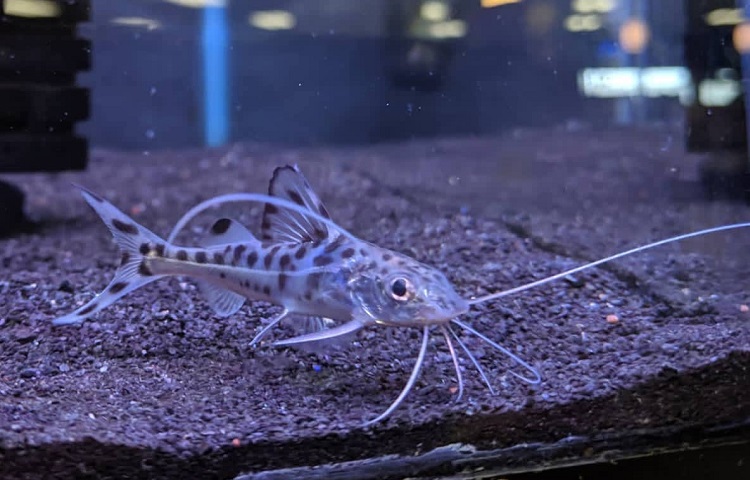
There are many pros to keeping Pictus Catfish in your tank that make them a popular choice for aquarists. Some of these pros are listed below.
- The Pictus Catfish is a very active and playful fish, and they love to explore its surroundings, which gives vitality to your aquarium.
- They are also peaceful and friendly fish that get along well with other tank mates, making them an excellent option for community tanks.
- These fish are relatively low maintenance. They can survive in a wide range of water parameters, which makes them an excellent choice for aquarists of different levels.
- The Pictus catfish has a unique appearance with their silvery body and dark stripes, which gives your tank a nice visual appeal.
Cons Of Having Pictus Catfish In Your Tank
Some cons of having them in your tank are:
- It is difficult to tell the difference between the male and female Pictus catfish.
- Raising the fry can be challenging.
- They take about three months to mature.

Ian Sterling, founder of Fishlab.com, began his aquarium journey over 30 years ago, driven by a deep fascination for fish and their diverse personalities. His website, Fishlab.com, is dedicated to making fishkeeping accessible and enjoyable, offering beginner-friendly guidance, expert insights, and a community for aquarists to connect and share experiences.


